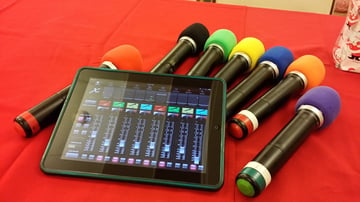
A successful wireless audio installation includes managing many pieces aside from the technical components. Yes, you need to set up a quality audio system that meets the client’s goals and performs perfectly, but you also need to carefully handle your relationship with the venue.
Building relationships with clients is a key skill that you should actively develop over time. Treating your clients like valued partners and aligning their goals with your own (instead of treating them like a quick paycheck) will smooth out any bumps along the way. A client who respects your work and enjoys your presence will overlook minor mistakes. He’ll also make sure you get paid.
Conducting a site visit

Naturally, you’ll want to visit a site or venue well before the installation. Your goal is to discuss the client’s needs and review the space. If the venue is undergoing construction of some kind (it’s not unusual to install audio equipment during remodels), you’ll need to know how the space is expected to change.
For simple installations (such as a church, school or conference room), you may only need a couple weeks to prepare. For concerts and other large-scale events, you should visit the site a few months before the event in case the venue is soliciting other quotes and/or you need to order or purchase any special equipment.
In some cases, the client will already have some existing equipment that you can integrate into their new system. Try your best to use whatever the client has on site in order to reduce their overall cost. You could recommend entirely new equipment to drive up the invoice, but that’s not a smart long-term strategy. You don’t want to earn a reputation as an over-charger.
If the client sends you a list of the equipment they already have on hand, offer thanks, but you still need to inspect their devices. It’s common for clients to not understand their own equipment and give installers like yourself bad information. Don’t rely on whatever they send you. As they say, “Trust, but verify.”
(Most of the time clients can’t tell you the type or model of their existing equipment anyway. They only care if the sound works.)
During your visit, make sure to take note of any de-installation required for existing equipment. This won’t be a challenge for you, but you should include the labor in your quote.
You should sketch the layout of the venue site, even if it’s small. Pictures are free, so take plenty of them. Later, it will help you explain the property to your team. If you conduct multiple site visits in a short time, it can be easy to confuse venues.
Working with the venue

Before you leave your office for the site visit, make a list of items you need to inspect. For instance, if there’s another venue nearby that uses wireless audio, you would want to check for interference or ask about or measure the frequencies they’re using. It’s too important to forget, otherwise you would have to return to the venue to check.
Don’t neglect the personal element of working with the venue. You might be a technically-minded person who wants to jump into the job, but don’t forget to build relationships.
When you arrive, don’t start poking around the property without meeting the owner. Shake hands and start with a topic the owner or planner will have answers to: Their goals. It’s critical that you uncover what they expect out of the project.
For instance, they might be willing to sacrifice some sound quality in exchange for an easy-to-use system. Or they might confess that even though they intend to use the space for lectures, they plan to use it for live music occasionally (which is a whole new ball game). You won’t know these details unless you ask.
When you’re speaking with the venue owner or event planner, they’ll only be concerned with two things: When you can complete the job and how much it will cost. You probably won’t have exact answers to those questions on site, but you’ll be beholden to any guesses you make. Even if you say “I’m not sure, but I think it will cost around $10,000,” you’ll disappoint the client if you come back with a bigger number. Wait to give out specifics until you’ve had a minute to price and schedule the job.
During your site visit and the installation, never forget that you’ll probably be working alongside other people and teams. Some will work for the venue. Others will be hired contractors like yourself. It’s important that you and your team maintain a professional demeanor at all times. If you’ll be expected to work with any of those people closely, introduce yourself right away.
Most importantly, have the venue owner or event planner sign a contract! It is remarkable how many audio system integrators get burned because they trusted the other party to pay. Suddenly there’s a dispute about the scope of the project, and now you’re doing more work than you expected. Or the other party “swears” you quoted a lower number.
It’s worth the cost to have an attorney draw up a basic contract that you can adjust for each client. Over time you’ll inevitably go back to that attorney for legal improvements to the document. A contract is used to protect your business, so take it seriously.
Creating and submitting your plan
In most cases, the venue will want to see your plans for the installation before you actually do the work. For small jobs, you can usually go over this in a conversation, but medium-to-large size jobs will require a submittal.
A submittal is a detailed plan of the equipment you’ll install, where it will be configured, and any accommodations you require from other teams. You should submit this document to any relevant team or personnel working with the venue. It’s best to give a submittal to more people, just in case. You don’t want someone making a change to the venue site because they didn’t know you would be installing or storing equipment in that area.
Your plan should be used as an internal document as well. You have to create a guide of some sorts for you and your team anyway, so it may as well be the same document. You may, however, want to omit technical details the client wouldn’t understand so your submittal is clearer.
If you’re like most audio integrators, you have equipment that you prefer to use or sell to your clients, so you won’t have to make many decisions in those regards. Always overestimate how much cable or hardware you’ll provide, as well as how much labor you’ll require. You can always adjust an invoice down if you feel you came under budget, but no client likes to hear “Sorry, costs were higher than we expected.”
If you haven’t at this time, you should attach a copy of your final invoice to your submittal along with any necessary paperwork. There is no industry standard payment terms, but it’s always smart to get paid before you invest the most expensive part of the process – the labor.
In some cases, event planners ask contractors to be paid within thirty days because they expect to collect revenue at the event. Your original contract should contain the proper terms for each job. Just make sure you are financially comfortable paying yourself and your team until the client pays.
When you begin planning your equipment, you should use a brand that’s trusted by more than 1,000 US and international technology integrators, live sound companies, and broadcast firms. Check out our antennas, distribution equipment, and our RF spectrum analysis software.
Dennis
Dennis Hammer is a content strategist and writer. He lives in Connecticut with his wife and daughter.
More from the blog
Subscribe to email updates
Stay up-to-date on what's happening at this blog and get additional content about the benefits of subscribing.




